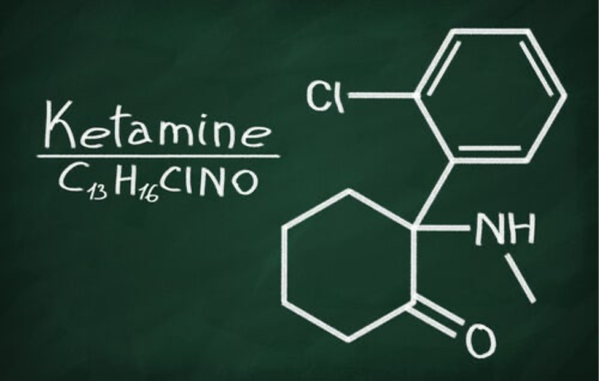The Drug Ketamine: Its Uses and Abuses

“I saw a light at the end of a tunnel.” This is a well-known phrase you often hear in the media about people’s “out of body” or “near-death” experiences. However, leave aside the paranormal for a moment. This is because a well-known anesthetic drug might be responsible for some of these experiences. It’s the drug ketamine.
These out-of-body experiences usually mean that the person has the sensation of looking back at their own physical body from a distance. However, some of the people that reported these experiences were, at the time, undergoing surgery under the anesthetic effects of ketamine.
Ketamine as a psychotropic drug
Ketamine is a drug that has powerful psychotropic properties. Therefore, it could provide a scientific explanation to the tunnel stories of near-death experiences.
Like other recreational drugs, ketamine generates perceptual dissociative phenomena in the individual. This means that your perceptions of both time and self become disordered and illogical.
Ultimately, your perception becomes distorted and completely jumbled up. You experience intermodal sensory transfers. For example, hearing a color or tasting a sound. Furthermore, in more extreme cases, your sense of time changes and reverses, expands, or contracts. Hence, you no longer recognize either the boundaries of your own body or your body parts.
Multisensory hallucinations, visual, auditory, taste, touch, and olfactory, occur frequently. In addition, you experience an altered state of consciousness, far away from real-time and place. This phenomenon is informally known as “a trip”.
According to people’s own accounts, they often meet and talk to dead people, fictional characters, or even different versions of themselves. It’s also quite common for the individual to believe they’ve died. Therefore, they might experience anxious excitement and intense emotions, particularly related to fear.

A controversial drug
When ketamine is used in a therapeutic and controlled way, such as in the operating theatre, the psychoactive effects are transient and reversible. However, if you ingest ketamine in different doses, you can experience a profound dissociative state known as a K-hole.
It can also make you see people and situations which don’t exist. This can make it difficult to reconcile yourself with reality. Furthermore, there’s a great risk of lasting after-effects and ketamine can cause psychotic outbreaks if you’re biologically predisposed to them.
These problems have made the use of ketamine highly controversial. Therefore, its legal use on humans has been restricted in recent years. Indeed, it’s sometimes only used as a last resort. However, in veterinary surgeries, it remains the anesthetic of choice for large animals.
The drug ketamine and its uses
Ketamine is a type of medication generally used for the induction and maintenance of anesthesia in human surgery, both adult and pediatric. It has the capacity to induce a trance-like state whilst also providing:
- Pain relief.
- Sedation.
- Memory loss.
In addition to surgical use, ketamine is also widely used in the veterinary field. Furthermore, it’s used to treat chronic pain and also for sedation in intensive care units. (ICU).
Whilst the drug is administered, checks are carried out on the heart and respiratory and other reflexes. Normally, it isn’t until the effects begin to wear off that undesirable side effects occur, such as:
- A rise in blood pressure.
- Respiratory depression.
- Involuntary muscle contractions.
- Agitation.
- Confusion.
- Hallucinations.
These are the effects of this drug if you use it illegally and for recreational purposes. Also, when it’s administered at higher dosages or not in accordance with clinical guidelines.
Alternative uses of ketamine
There are legal restrictions surrounding the usage of ketamine. In fact, it’s now widely considered an addictive drug. However, despite the resistance of clinical, pharmaceutical, and patient groups themselves, numerous research has been conducted on alternative uses for the drug.
“Declare the past, diagnose the present, foretell the future.”
-Hippocrates-
Ketamine works by blocking the well-known NMDA receptor (N-methyl-D-aspartate). This reduces brain activity, as well as hindering memory retention and temporarily relieving symptoms of depression.
This action, along with its pharmacokinetics and pharmacodynamics, makes ketamine a powerful anesthetic and sedative. Therefore, it’s very useful medically. Furthermore, the drug acts in a dissociative manner due to its link to the NMDA receptor.
The aforementioned uses are typical in clinical practice. However, there are less widespread uses ketamine seems to be a suitable alternative for:
- As an adjuvant in the treatment of depression.
- As a hypnotic or sleep-inducing drug.
- To reduce the incidence of seizures,
- As a neuroprotector, especially in cases of brain damage,
- To help mitigate the effects of post-traumatic stress disorder.
- Also, to treat obsessive-compulsive disorder.
- To reduce symptoms of asthma.

The drug ketamine and depression
There are a number of new uses attributable to ketamine. However, the one that seems most likely to be rolled out and to receive clinical marketing is its use as a complement to anti-depressive therapy.
This is a world away from the established monoamine hypothesis that for decades has fuelled the research and production of anti-depressant drugs. In fact, what’s really new is that those patients that seem to benefit most from ketamine are the ones that didn’t get many benefits from traditional anti-depressants.
Indeed, ketamine acts in a way that other anti-depressants don’t, by helping patients whose depression is resistant to the usual drugs. These results came as a surprise to many scientists.
This all goes to show that, sometimes, solutions are much closer than we think. Indeed, we’re often so eager to achieve great things, we tend to look far and wide for answers. Thus, it comes as a great surprise when we discover that the solution was right in front of our eyes.
All cited sources were thoroughly reviewed by our team to ensure their quality, reliability, currency, and validity. The bibliography of this article was considered reliable and of academic or scientific accuracy.
- Harrison NL, Simmonds MA (febrero de 1985). «Quantitative studies on some antagonists of N-methyl D-aspartate in slices of rat cerebral cortex». British Journal of Pharmacology 84 (2): 381-91.
- Morgan, Celia J. A.; Muetzelfeldt, Leslie; Curran, H. Valerie (2009). «Consequences of chronic ketamine self-administration upon neurocognitive function and psychological wellbeing: a 1-year longitudinal study». Addiction 105 (1): 121.
This text is provided for informational purposes only and does not replace consultation with a professional. If in doubt, consult your specialist.








